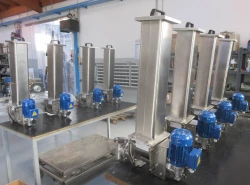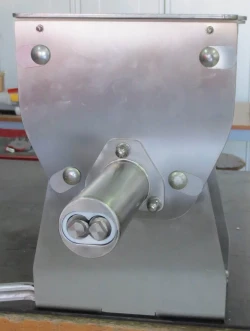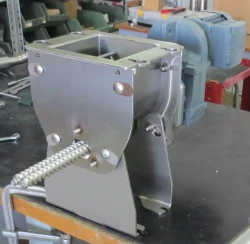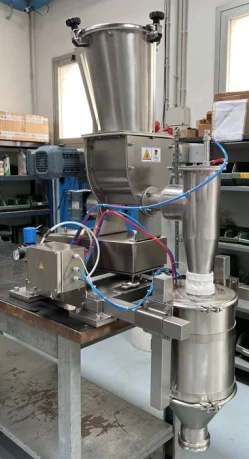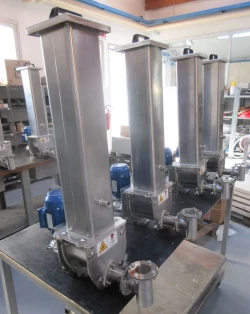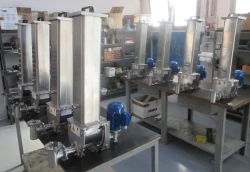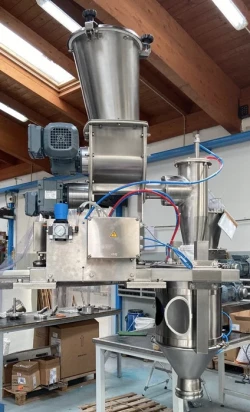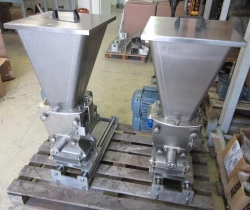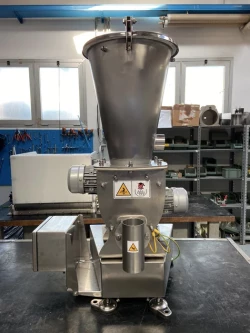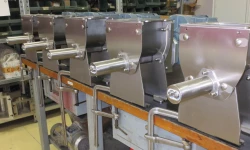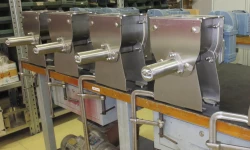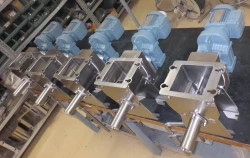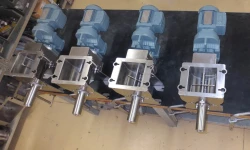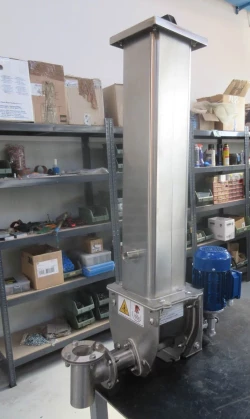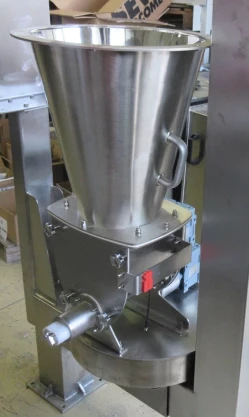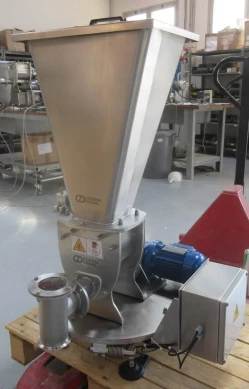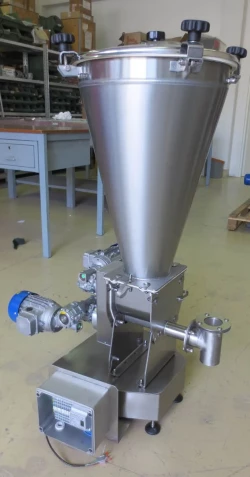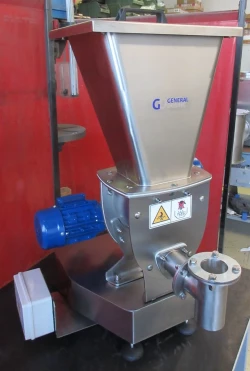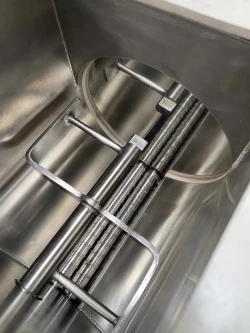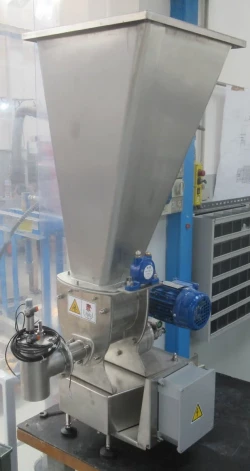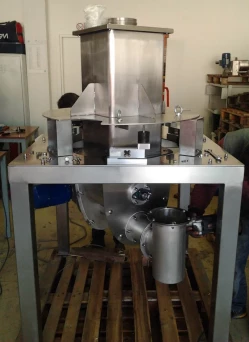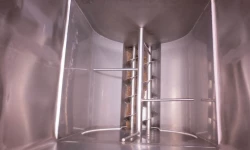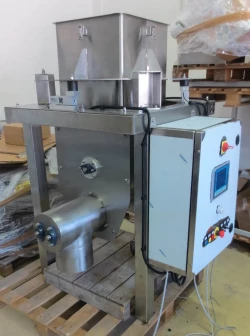Volumetric and Gravimetric Twin Screw Dosers
series BH, BHW, BHY
Twin screw volumetric dosers series BH
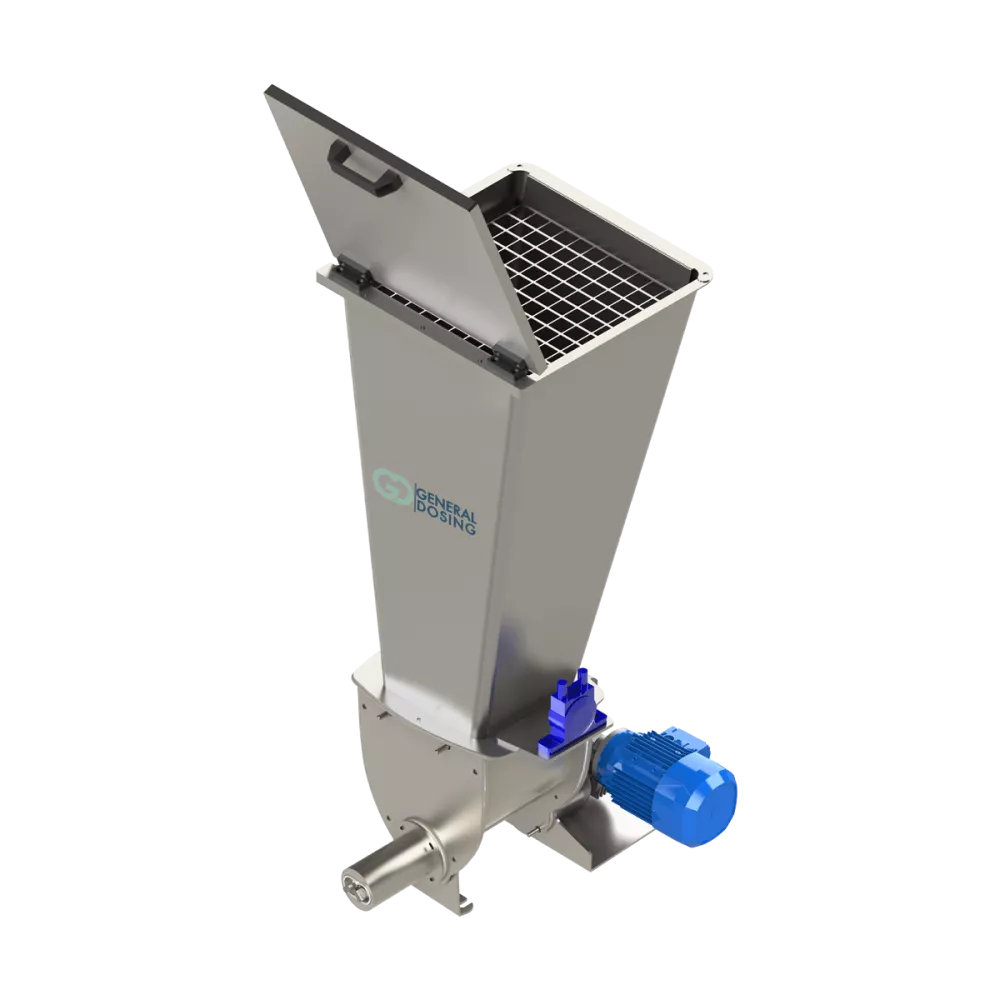
Twin screw gravimetric dosers installed on single point load cell platform series BHW
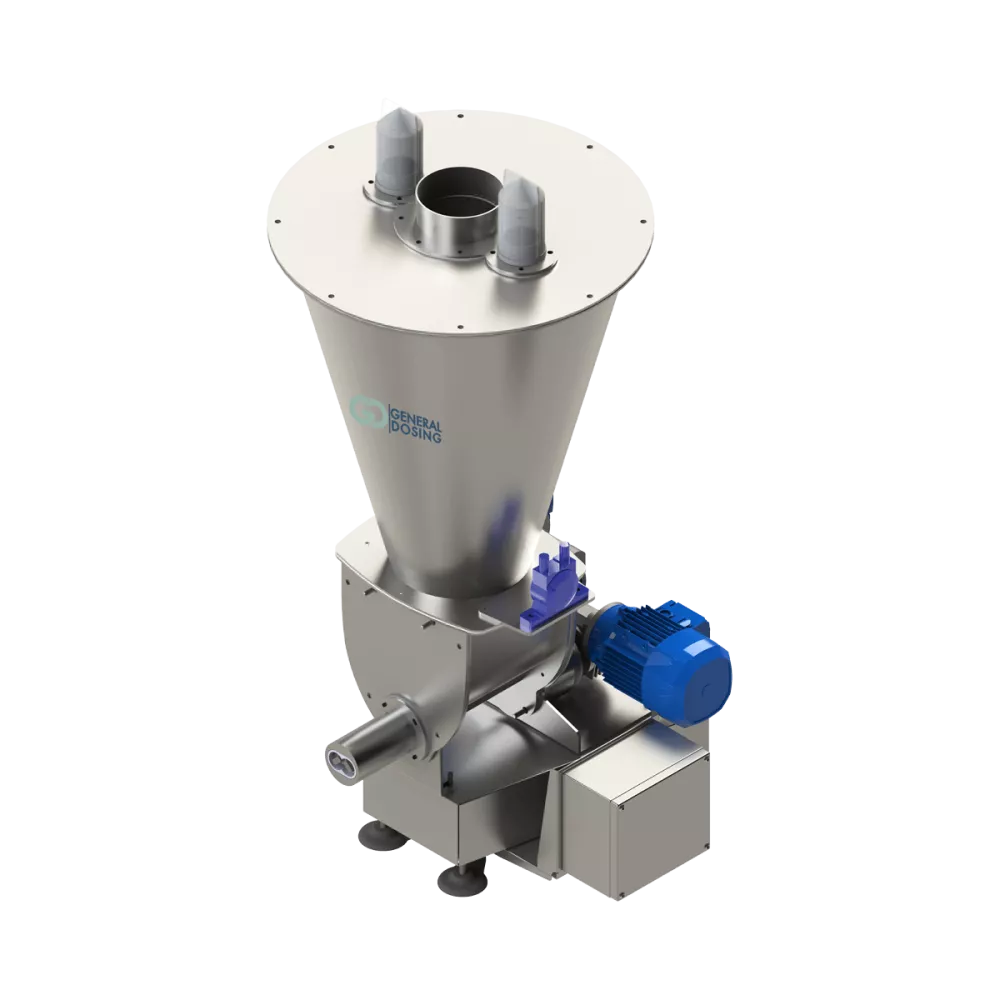
Twin screw gravimetric dosers installed hanging on load cells series BHY
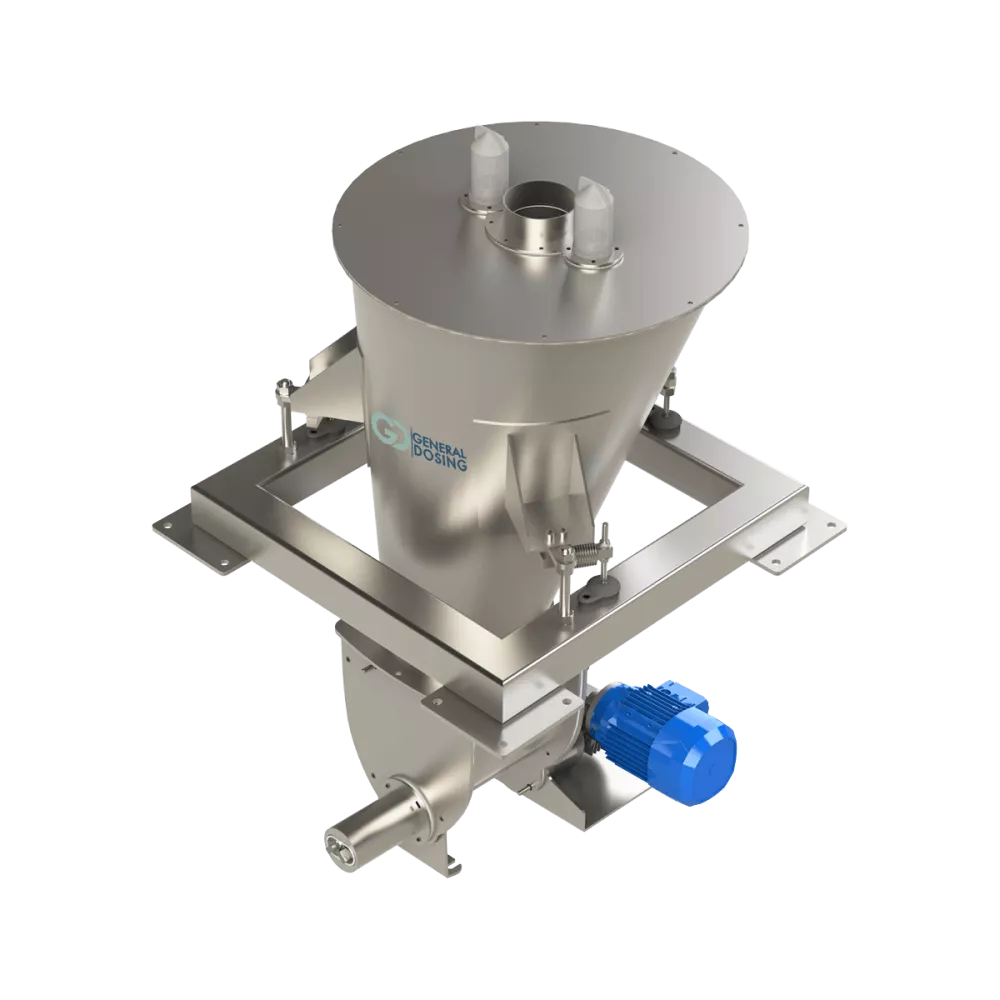
The dosing tool for these kind of dosers consists in a couple of twin and co-rotating horizontal screws.
These are machines particularly suitable to dose compact, hygroscopic and cohesive powders. They can be used to dose products with waxes, gums, fat components and also paste or cream products.
The dosing screws are coupled so as to make them compenetrating one to eachother.
Different types of interchangeable screws are available to choose according to the product characteristics. The dosing screws are machined out manufactured with fool flight, lowered ridge or concave self-cleaning. It is possible to have different pitch geometry: square , long or reduced and with single or double principle.
The dosing screws are machined out manufactured. The most provided models are fool flight type, lowered ridge or concave. Their pitch can have different geometries: square , long or reduced and with single or double principle.
The front side of the doser from which the product comes out has an outlet tube, which contains the terminal part of the dosing screws. The tube is flanged to the body of the doser and it can be removed to allow the dosing screws dismantling. Each one of the dosing screw is fixed to its motor shaft through a bayonet connection.
The outlet tube has an adaptor fit inside, made in silicone material printing, and has very tight mechanical tolerances. This makes the product outlet zone to be a kind of containing labyrinth useful to prevent siphoning effects that can occur with very flowing products.
The body of the doser has a trough shape with a specific geometry suitable to house both the dosing screws and a horizontal agitator. This last one action is fundamental to avoid the formation of bridges that can occur mostly with compact and poorly flowing products. The horizontal agitator also feeds the dosing screws regularly and constantly, which is very important in order to have a good dosing repeatability.
There are different horizontal agitator models to choose according to the product characteristics. They can be equipped with different stirring tools such as blades, ploughshares, combs, helix and combination of these types.
The body of the doser is completely openable removing the front flange which is tightened with nuts and bolts. In this way it is possible to have access to the dosing screw and to the horizontal agitator that can be easily removed to be cleaned and sanitized.
Are also available versions equipped with knobs and safety microswitch, instead of bolts and nuts, that allow to open the body of the doser more quickly. This arrangement is useful when the cleaning operations are frequent, as it happens for example in the food sector or in all the cases where the contamination among different products is not allowed.
Vertical T spouts complete the set of this kind of dosers. They are mounted at the end of the front outlet tube to vertically guide the product falling down while dosing. Discharges equipped with automatic plug, slide or butterfly valves are also available. These devices have the function to intercept the product while falling down. In the batch dosages they are particularly suggested to obtain the maximum accuracy and in general to avoid the spontaneous product leakage, especially if very free flowing, when the doser is on break.
The transmission groups that move the dosing screw and the horizontal agitator are constituted by worm type gearboxes and three-phase electric motors. In cases where a very wide throughput range is required (the range between the minimum and maximum dosage capacity is more than 1 to 10) brushless type motors are used, that allow very slow rotation speed so as to achieve very small capacities.
The mechanical transmission which operates the dosing screws has a divider, constituted by a compact box which houses bearings, seal rings and gears. Its function is to split the motion generated by a single gear motor.
The shaft mechanical seals are made with shielded bearings and dust tight rings available in various materials such as NBR, SILICONE, PTFE and VITON. Air flushed sealing groups are also available for the hardest cases.
Atex certified motors are available eventually equipped with a temperature probe and an anti-condensation heating devices when it is requested.
The dosing screws motor can be controlled by a frequency converter , and can be eventually servoventilated. The brushless type motors are controlled by their specific digital servo-drive. Using these controlling devices it is possible to regulate the rotation speed of the dosing screw in order to obtain the wanted capacity in a predefined minimum and maximum range. The real achievable capacity range depends also on the characteristics of the product to dose. Using asynchronous motors generally it can be covered a range from 1 to 8 between minimum and maximum . The adjustment range can increase until 1 to 30 using brushless motors.
The transmission groups can be equipped with a device for detecting the direction of rotation of the dosing screws and of the horizontal agitator. The device is made of a inductive sensor and a flap keyed on the slow shaft of the gear motor. Everything is protected by an aluminum restraint box with a transparent polycarbonate sight glass.
The entire range of BH, BHW e BHY dosers is constituted by 6 standard sizes that allow to cover a range from a minimum of 0,1kg/h to a maximum of 10.000 kg/h.
The hoppers can have a polygonal or truncated conical, symmetrical or skewed shape and their design ensure a correct out flow and complete emptying even with poorly flowing products. The polygonal hoppers have rounded corners to allow a complete and easy cleaning; they can be equipped with wide transparent polycarbonate sight glasses and inspection window as needed. The hoppers truncated conical shaped can have a vertical agitator, which is useful for particularly compact products, that stick to the walls and have to be forced to come down the dosing body. Agitators with different geometric shape are available to chose according to the product characteristics.
The hoppers can be manually or automatically loaded.
The hoppers loaded manually have a completely removable lid or semi-openable with hinges. Inside it there is a safety grid which protects from the risk of contact with moving parts of the doser and prevents the accidental access of foreign matter that could damage the doser.
The hoppers automatically loaded have bolted lids with a round inlet and a vent socket equipped with a bag in polyester filtering fabric sleeve.
As accessories of the hoppers there are level sensors, to detect the presence of product, and pneumatic vibrators or moto vibrators to prevent the formation of bridges. The most used sensors are capacitive types, rotary level sensors, vibrating level switches to choose according to the product characteristics.
In the gravimetric version, the doser can be installed on a proper platform scale(BHW) or hung to load cells with its hopper (BHY). The load cells are off-center or flexion type, made in aluminium or in stainless steel with protection grade up to IP67, available also with Atex certification when requested.
The most used construction materials are stainless steel Aisi 304 and 316L, but it is also possible to provide carbon steel on request.
The surfaces in contact with the product can be easily pickled or mirror polished in case of poorly flowing products. It is possible to have certifications of the contact materials on request.
The external surfaces are satin finished 180 mesh. It is possible to have them glass bead blasted or electro-polished on request.
The gaskets are made in dust-tight rubber , such as SBR or NBR. They are available also with FDA certification on request.
Both volumetric CH and gravimetric CHW and CHY dosers can be Atex 21/22 and Atex 21/21 certified, if required.
Electrical control panels can also be supplied including software specifically designed accordingly to the requested functionality.
The dosing screws are machined out manufactured. The most provided models are fool flight type, lowered ridge or concave. Their pitch can have different geometries: square , long or reduced and with single or double principle.
The front side of the doser from which the product comes out has an outlet tube, which contains the terminal part of the dosing screws. The tube is flanged to the body of the doser and it can be removed to allow the dosing screws dismantling. Each one of the dosing screw is fixed to its motor shaft through a bayonet connection.
The outlet tube has an adaptor fit inside, made in silicone material printing, and has very tight mechanical tolerances. This makes the product outlet zone to be a kind of containing labyrinth useful to prevent siphoning effects that can occur with very flowing products.
The body of the doser has a trough shape with a specific geometry suitable to house both the dosing screws and a horizontal agitator. This last one action is fundamental to avoid the formation of bridges that can occur mostly with compact and poorly flowing products. The horizontal agitator also feeds the dosing screws regularly and constantly, which is very important in order to have a good dosing repeatability.
There are different horizontal agitator models to choose according to the product characteristics. They can be equipped with different stirring tools such as blades, ploughshares, combs, helix and combination of these types.
The body of the doser is completely openable removing the front flange which is tightened with nuts and bolts. In this way it is possible to have access to the dosing screw and to the horizontal agitator that can be easily removed to be cleaned and sanitized.
Are also available versions equipped with knobs and safety microswitch, instead of bolts and nuts, that allow to open the body of the doser more quickly. This arrangement is useful when the cleaning operations are frequent, as it happens for example in the food sector or in all the cases where the contamination among different products is not allowed.
Vertical T spouts complete the set of this kind of dosers. They are mounted at the end of the front outlet tube to vertically guide the product falling down while dosing. Discharges equipped with automatic plug, slide or butterfly valves are also available. These devices have the function to intercept the product while falling down. In the batch dosages they are particularly suggested to obtain the maximum accuracy and in general to avoid the spontaneous product leakage, especially if very free flowing, when the doser is on break.
The transmission groups that move the dosing screw and the horizontal agitator are constituted by worm type gearboxes and three-phase electric motors. In cases where a very wide throughput range is required (the range between the minimum and maximum dosage capacity is more than 1 to 10) brushless type motors are used, that allow very slow rotation speed so as to achieve very small capacities.
The mechanical transmission which operates the dosing screws has a divider, constituted by a compact box which houses bearings, seal rings and gears. Its function is to split the motion generated by a single gear motor.
The shaft mechanical seals are made with shielded bearings and dust tight rings available in various materials such as NBR, SILICONE, PTFE and VITON. Air flushed sealing groups are also available for the hardest cases.
Atex certified motors are available eventually equipped with a temperature probe and an anti-condensation heating devices when it is requested.
The dosing screws motor can be controlled by a frequency converter , and can be eventually servoventilated. The brushless type motors are controlled by their specific digital servo-drive. Using these controlling devices it is possible to regulate the rotation speed of the dosing screw in order to obtain the wanted capacity in a predefined minimum and maximum range. The real achievable capacity range depends also on the characteristics of the product to dose. Using asynchronous motors generally it can be covered a range from 1 to 8 between minimum and maximum . The adjustment range can increase until 1 to 30 using brushless motors.
The transmission groups can be equipped with a device for detecting the direction of rotation of the dosing screws and of the horizontal agitator. The device is made of a inductive sensor and a flap keyed on the slow shaft of the gear motor. Everything is protected by an aluminum restraint box with a transparent polycarbonate sight glass.
The entire range of BH, BHW e BHY dosers is constituted by 6 standard sizes that allow to cover a range from a minimum of 0,1kg/h to a maximum of 10.000 kg/h.
The hoppers can have a polygonal or truncated conical, symmetrical or skewed shape and their design ensure a correct out flow and complete emptying even with poorly flowing products. The polygonal hoppers have rounded corners to allow a complete and easy cleaning; they can be equipped with wide transparent polycarbonate sight glasses and inspection window as needed. The hoppers truncated conical shaped can have a vertical agitator, which is useful for particularly compact products, that stick to the walls and have to be forced to come down the dosing body. Agitators with different geometric shape are available to chose according to the product characteristics.
The hoppers can be manually or automatically loaded.
The hoppers loaded manually have a completely removable lid or semi-openable with hinges. Inside it there is a safety grid which protects from the risk of contact with moving parts of the doser and prevents the accidental access of foreign matter that could damage the doser.
The hoppers automatically loaded have bolted lids with a round inlet and a vent socket equipped with a bag in polyester filtering fabric sleeve.
As accessories of the hoppers there are level sensors, to detect the presence of product, and pneumatic vibrators or moto vibrators to prevent the formation of bridges. The most used sensors are capacitive types, rotary level sensors, vibrating level switches to choose according to the product characteristics.
In the gravimetric version, the doser can be installed on a proper platform scale(BHW) or hung to load cells with its hopper (BHY). The load cells are off-center or flexion type, made in aluminium or in stainless steel with protection grade up to IP67, available also with Atex certification when requested.
The most used construction materials are stainless steel Aisi 304 and 316L, but it is also possible to provide carbon steel on request.
The surfaces in contact with the product can be easily pickled or mirror polished in case of poorly flowing products. It is possible to have certifications of the contact materials on request.
The external surfaces are satin finished 180 mesh. It is possible to have them glass bead blasted or electro-polished on request.
The gaskets are made in dust-tight rubber , such as SBR or NBR. They are available also with FDA certification on request.
Both volumetric CH and gravimetric CHW and CHY dosers can be Atex 21/22 and Atex 21/21 certified, if required.
Electrical control panels can also be supplied including software specifically designed accordingly to the requested functionality.
Il fronte anteriore del dosatore da cui esce il prodotto presenta un musetto di forma cilindrica che contiene la parte terminale delle viti di dosaggio. Il musetto è bullonato al corpo del dosatore e può essere rimosso per consentire lo smontaggio veloce delle viti di dosaggio che sono fissate ciascuna al loro albero motore mediante un attacco a baionetta. La sede del musetto che ospita le viti di dosaggio, realizzata per stampaggio in materiale siliconico, ha delle tolleranze meccaniche molto ristrette. Questo allestimento fa si che la zona di uscita del prodotto sia un vero e proprio labirinto di contenimento atto a prevenire fenomeni di sifonaggio che si possono verificare con prodotti molto scorrevoli.
Il corpo del dosatore ha la forma di truogolo avente una geometria idonea ad ospitare sia le viti di dosaggio che un rotore orizzontale ad aspi. L’azione di quest’ultimo è fondamentale per evitare la formazione di ponti che si possono presentare soprattutto con prodotti compatti e poco scorrevoli. Il rotore ad aspi inoltre tiene alimentate le viti di dosaggio in modo regolare e costante, fattore questo molto importante per avere una buona ripetibilità di dosaggio.
Esistono vari modelli di rotori ad aspi da scegliersi in base alle caratteristiche del prodotto. Gli aspi infatti possono avere diverse forme, come lame, vomeri, pettini, eliche ed anche combinazioni miste di queste tipologie.
Il corpo del dosatore è completamente apribile rimuovendo la flangia frontale che viene serrata mediante bulloni e dadi. In questo modo è possibile accedere alla coclea di dosaggio e al rotore ad aspi che possono facilmente essere smontati per essere puliti e sanificati.
Sono disponibili anche versioni dotate di pomelli e microinterruttori di sicurezza, al posto dei bulloni di serraggio, che consentono di aprire il corpo in modo più rapido. Condizione questa molto utile quando le operazioni di pulizia sono frequenti, come avviene ad esempio in ambito alimentare o in tutti quei casi in cui si debba evitare contaminazione tra prodotti diversi.
Completano l’allestimento di questa tipologia di dosatori opportuni scarichi verticali a “T” che vengono montati all’estremità delle viti per guidare il prodotto in caduta durante il dosaggio. Sono disponibili anche scarichi muniti di dispositivi di chiusura a clapè o a serranda comandati elettro-pneumaticamente. Questi dispositivi hanno la funzione di interrompere istantaneamente il flusso di prodotto in uscita. Sono particolarmente indicati per ottenere la massima precisione nei dosaggi a batch ed in generale per evitare la fuoriuscita spontanea di prodotto, soprattutto se molto scorrevole, quando il dosatore è in pausa.
I gruppi di trasmissione che mettono in rotazione rispettivamente le viti di dosaggio e il rotore ad aspi sono costituite da riduttori a vite senza fine e da motori elettrici trifase. Nei casi in cui viene richiesto un campo di lavoro molto ampio ( il rapporto tra la massima portata di dosaggio e la minima è superiore a 1 su 10 ) vengono utilizzati motori brushless, che consentono di ottenere velocità di rotazione molto lente in modo da realizzare portate molto basse. La trasmissione meccanica che aziona le viti di dosaggio presenta un modulo ripartitore, costituito da un box compatto che alloggia ingranaggi e tenute, la cui funzione è quella di sdoppiare il moto generato da un unico motoriduttore.
Le tenute degli alberi sono realizzate con cuscinetti schermati e anelli parapolvere disponibili in diversi materiali come NBR, SILICONE, PTFE EPDM e VITON. Sono disponibili anche tenute flussate ad aria per i casi più gravosi.
Sono disponibili motori certificati Atex, eventualmente completi di sonda di temperatura e scaldiglia anticondensa, nei casi in cui è richiesto.
Il motore delle viti di dosaggio può essere comandato da inverter, ed essere eventualmente servo-ventilato, o da servo-azionamento digitale nel caso di motore brushless. Utilizzando questi dispositivi si regola la velocità di rotazione della coclea di dosaggio in modo da ottenere la portata voluta in un range minimo e massimo predefinito. Il reale campo di portata ottenibile dipende anche dalle caratteristiche del prodotto da dosare. Utilizzando motori asincroni si riesce a coprire generalmente almeno un range di 1 a 8 tra valore di minima e massima portata. Il campo si può aumentare fino diventare di 1 a 30 utilizzando motori brushless.
I gruppi di trasmissione possono essere dotati di un dispositivo per il controllo del senso di rotazione delle viti di dosaggio e del rotore ad aspi. Il dispositivo è’ composto da un sensore induttivo e da una paletta calettata sull’ albero lento dei motoriduttore. Il tutto è protetto da un box di contenimento realizzato in alluminio con una spia visiva in policarbonato trasparente.
L’intera gamma di dosatori BH, BHW e BHY è costituita complessivamente da 6 taglie standard che consentono di coprire un range di portata che va da un minimo di 0,1 Kg/h ad un massimo di 10.000 Kg/h.
Ai dosatori è possibile associare un’ampia varietà di tramogge di carico standard con diverse capacità.
Le tramogge possono avere forma poligonale o tronco-conica, simmetriche o sghembe e sono progettate in modo da garantire un corretto svuotamento anche con prodotti scarsamente scorrevoli. Le tramogge poligonali hanno angoli arrotondati per consentire una completa ed agevole pulizia e possono essere dotate all’occorrenza di ampie specole visive e di oblò di ispezione in policarbonato trasparente. Le tramogge di forma tronco-conica possono essere dotate di un rotore verticale ad aspi, dispositivo utile per prodotti particolarmente compatti, che si attaccano alle pareti e devono essere forzati a scendere nel corpo del dosatore. Sono disponibili aspi di diversa forma e geometria in funzione delle caratteristiche del prodotto.
Le tramogge possono essere caricate manualmente o automaticamente.
Le tramogge che vengono caricate manualmente sono dotate di coperchio completamente amovibile oppure semi-apribile con cerniere. All’interno è presente una griglia di sicurezza che protegge dal rischio di contatto con gli organi in movimento e che previene l’ingresso accidentale di corpi estranei di dimensioni tali da danneggiare il dosatore.
Le tramogge caricate automaticamente hanno coperchi bullonati provvisti di una bocca di alimentazione e di un camino di sfiato dotato di una manica in tessuto filtrante di poliestere. Come accessori delle tramogge si possono avere sensori di livello per segnalare la presenza di prodotto e vibratori pneumatici o moto vibratori per prevenire la formazione di ponti. I sensori maggiormente utilizzati sono capacitivi, rotativi a paletta, a vibrazione da scegliersi in funzione delle caratteristiche del prodotto.
Nella versione gravimetrica il dosatore può essere montato su una apposita piattaforma bilancia ( BHW ) oppure appeso a celle di carico tramite la sua tramoggia ( BHY ). Le celle di carico utilizzate sono del tipo off-center, a flessione o a al taglio, in alluminio o acciaio inox, disponibili anche in versione Atex nei casi in cui è richiesto.
Sia i dosatori volumetrici BH che quelli gravimetrici BHW e BHY possono essere certificati Atex 21/22 e Atex 21/21.
I materiali di costruzione maggiormente utilizzati sono l’acciaio inox Aisi 304 e 316L, ma è possibile anche l’utilizzo di acciaio al carbonio su richiesta.
Le superfici a contatto con il prodotto possono essere semplicemente passivate o anche lucide a specchio nel caso di prodotti con scarsa scorrevolezza. E’ possibile avere su richiesta le certificazioni dei vari materiali a contatto.
Le superfici esterne sono satinate 180 mesh. E’ possibile averle anche micro-pallinate o elettro-lucidate su richiesta.
Per le guarnizioni vengono utilizzate gomme idonee per la tenuta polveri, come SBR o NBR. Sono disponibili anche gomme alimentari anche con certificazioni FDA su richiesta.
A completamento possono essere forniti quadri elettrici e relativi pannelli di controllo con dotazione di software progettato specificamente per assolvere alle funzionalità richieste.

